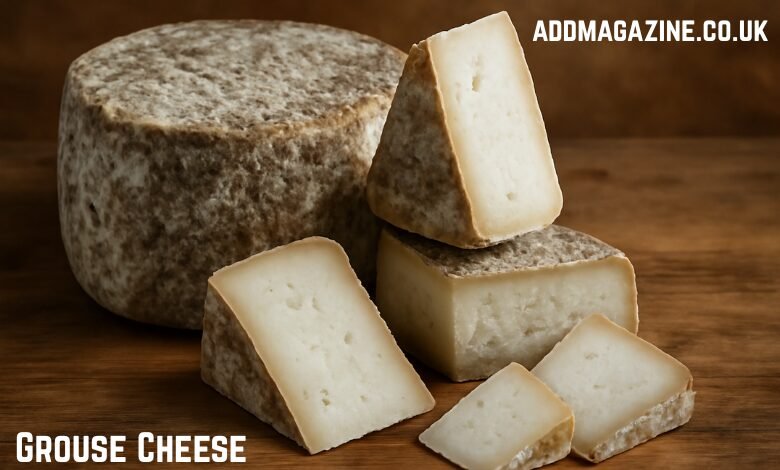Grouse cheese is a type of artisan cheese made from the milk of specific breeds of goats, often including local, heritage, or wild varieties. Its unique characteristics stem from both the milk used and the techniques employed in its production. While less widely known than other goat cheeses, grouse cheese is increasingly gaining popularity among cheese enthusiasts who seek out distinctive flavors and regional varieties.
In this blog post, we will take a deep dive into the history, production methods, flavor profile, and uses of grouse cheese. From its origins to its growing appeal in culinary circles, we will explore what makes this cheese stand out.
What is Grouse Cheese?
At its core, grouse cheese is made from the milk of goats, specifically ones that are chosen for their ability to produce high-quality, rich milk. The name “grouse” could refer to either the regional context of where the cheese is produced or the specific type of goat breed used. Often produced on small, local farms, this cheese is not mass-produced like some mainstream varieties. This means that it tends to carry with it a sense of place — a distinctive flavor profile that reflects the landscape, climate, and traditional methods used in its creation.
The Origin and Story of Grouse Cheese: A Unique Artisan Delight
Grouse cheese is a lesser-known, yet highly regarded, type of goat’s milk cheese, appreciated by connoisseurs for its distinct flavor profile and traditional methods of production. While it is not as widely known as more mainstream goat cheeses, such as chèvre, grouse cheese’s increasing popularity has caught the attention of food lovers and chefs alike. This article delves into the origin of grouse cheese, its production process, and how it has become a cherished part of the cheese world.
The Beginnings of Grouse Cheese: An Artisan’s Tale
Grouse cheese traces its origins back to the late 19th century in rural, mountainous regions where goats have long been a staple of farming communities. The cheese was likely born out of necessity, as people sought ways to preserve milk during times when refrigeration was not available. The mountainous areas provided a unique climate and environment that suited specific breeds of goats, which became the primary source of milk for the production of this cheese.
Although the exact date of the first grouse cheese production is unclear, the 1800s marked the era when small, family-run farms began experimenting with cheeses made from goat’s milk. These local producers would refine their techniques over time, passing down methods from one generation to the next.
By the early 20th century, grouse cheese had developed a reputation for its bold flavors and creamy texture. It was produced mainly in small, isolated farms in regions with a deep history of cheesemaking, where the terrain and local flora played an integral role in shaping the cheese’s distinctive taste.
Production Methods
The production of grouse cheese has remained relatively unchanged for over a century, following time-honored traditions that emphasize quality and artisanal techniques. The process begins with fresh, high-quality goat’s milk. For the first few decades, this milk was gathered from a handful of goat breeds unique to the regions, but today, it often comes from specific local breeds, which are known for producing richer milk.
Grouse cheese is traditionally made through a method known as coagulation, where the milk is curdled using natural enzymes or rennet. After curdling, the curds are separated from the whey, and the resulting mass is either pressed or molded into the desired shape. Unlike many modern cheeses, grouse cheese is often aged for several months to develop its characteristic complex flavor profile.
The 1940s to 1960s saw an increase in regional production of artisan cheeses, including grouse cheese, as demand grew for more locally sourced, high-quality products. During this period, farmers began to experiment with various aging techniques, which led to variations in flavor and texture. Some producers would age the cheese in caves, while others would wrap it in herbs or spices to infuse additional flavors, resulting in a broader range of products within the same category.
Flavor Profile
By the 1970s, grouse cheese had earned a reputation for its rich, complex flavors. The flavor profile of grouse cheese can vary depending on factors like the breed of goat, the specific environment, and the aging process. Typically, the cheese has a tangy, savory taste with notes of earthiness that can range from mild to sharp, depending on how long the cheese has been aged.
Younger versions of grouse cheese are smooth and creamy, with a subtle, almost buttery flavor. These cheeses tend to be soft, spreadable, and perfect for pairing with fresh fruit or crackers. Older versions, aged for several months or more, develop a firmer texture and sharper flavor. The tanginess intensifies, and the cheese may take on a slightly crumbly consistency.
One of the most distinctive features of grouse cheese is its versatility. While many goat cheeses can be overwhelming in their tanginess, grouse cheese strikes a balance, allowing it to be used in everything from savory dishes like salads and roasted vegetables to desserts that incorporate its sweetness and earthiness.
Uses in Cooking
Grouse cheese can be used in a wide variety of dishes, from salads to pasta, and it pairs wonderfully with both savory and sweet flavors. Its creamy texture makes it ideal for spreading on bread or crackers, while its more aged varieties can be grated over dishes or added to sauces for depth of flavor.
One of the most popular ways to use grouse cheese is by pairing it with fruit and nuts. The tangy, rich flavor of the cheese complements the sweetness of fruits like pears, figs, and apples, while the crunchiness of nuts like almonds and walnuts adds texture to the dish. It also works well in warm dishes, such as roasted vegetables, omelets, or as part of a cheese board served with a selection of charcuterie and bread.
For more adventurous cooks, grouse cheese can be melted into sauces or served alongside grilled meats, particularly lamb or chicken. It can also be used to fill savory pastries or turnovers, lending its unique flavor to these rich, flaky treats.
Pairing Grouse Cheese with Wine
Cheese and wine pairing is an art form, and grouse cheese is no exception. When pairing wine with grouse cheese, it’s important to consider the intensity of the cheese’s flavor. For younger, creamier versions of grouse cheese, a light, crisp white wine like Sauvignon Blanc or a sparkling wine like Champagne can provide a refreshing contrast to the cheese’s richness.
For more mature or aged grouse cheeses, red wines with more body, such as a Merlot or a Bordeaux blend, can complement the bold, savory flavors of the cheese. The saltiness of the cheese pairs particularly well with wines that have a good balance of acidity and fruitiness, allowing the wine to cut through the richness of the cheese while enhancing its flavors.
Modern-Day Production and Popularity
While its roots are firmly planted in the past, grouse cheese has seen a resurgence in popularity over the last few decades, particularly as the global appreciation for artisan cheeses has grown. As of the 2010s, the demand for gourmet and locally produced cheeses has increased significantly. This shift is part of a broader trend toward farm-to-table eating, where consumers are more conscious of where their food comes from and the methods used to produce it.
In many ways, this resurgence parallels the broader rise of the artisan cheese movement, which began in the mid-20th century and gained momentum in the 1980s and 1990s. More cheesemakers have embraced small-batch, hand-crafted cheeses, and as a result, cheeses like grouse have made their way into fine dining restaurants, specialty cheese shops, and farmers’ markets around the world.
The late 2010s and early 2020s marked a significant moment for grouse cheese, as it began appearing on more international cheese boards, festivals, and culinary events. As chefs and consumers increasingly sought distinctive, lesser-known cheeses, grouse cheese’s unique flavor profile made it a standout.
Health Benefits of Grouse Cheese
Like most cheeses, grouse cheese is a source of protein and calcium, making it beneficial for bone health. It also contains a range of vitamins, such as Vitamin A, Vitamin D, and Vitamin B12, all of which contribute to overall health. The fat content in goat cheese is typically lower than that found in cow’s milk cheeses, making it a popular choice for those who are looking for a slightly lighter alternative.
Additionally, goat’s milk is often considered easier to digest than cow’s milk, which makes cheeses made from goat milk, like grouse cheese, a good option for those who are lactose intolerant or have mild sensitivities to dairy. While it is not completely lactose-free, many people with lactose intolerance find goat cheese to be more tolerable than cheeses made from cow’s milk.
Where to Buy Grouse Cheese
Grouse cheese can be found at premium cheese shops, local farmer’s markets, and select high-end grocery stores. Because it is often produced in small batches and is not mass-produced, it may not be as widely available as other types of cheese. However, with the growing demand for artisan and locally-produced foods, more shops are carrying a variety of artisanal cheeses, including grouse cheese.
If it’s not available nearby, many online retailers offer direct shipping for artisanal cheeses, allowing you to enjoy different varieties of grouse cheese from the comfort of your home.
How to Enjoy Grouse Cheese Today
Today, grouse cheese is often used in a variety of dishes and is known for pairing well with a wide range of ingredients. Its smooth, creamy texture makes it an excellent addition to salads, charcuterie boards, and pasta dishes. It can also be used in savory pastries, on top of grilled meats, or melted into sauces for added depth.
When paired with wine, younger versions of grouse cheese work well with crisp white wines like Sauvignon Blanc or Chardonnay, while the more aged varieties are best suited to fuller-bodied red wines such as Merlot or Cabernet Sauvignon.
Grouse cheese has also found its place in gourmet restaurants, where it is often used to create unique cheese plates, paired with fresh fruits, honey, and nuts. In home kitchens, it can be spread on toast, crumbled over roasted vegetables, or even served with dark chocolate to bring out its earthy flavors.
Conclusion
Grouse cheese is a unique and flavorful artisan cheese that has a long history rooted in traditional cheesemaking practices. With its tangy, rich flavor and versatility in the kitchen, it has earned a place in the hearts of cheese lovers who appreciate the art of crafting small-batch, local cheeses. Whether you’re pairing it with wine, adding it to a dish, or enjoying it on its own, grouse cheese is a delightful addition to any cheese board or culinary creation. As the world of artisan cheeses continues to expand, grouse cheese is sure to find its place among the best that the world of cheesemaking has to offer.




